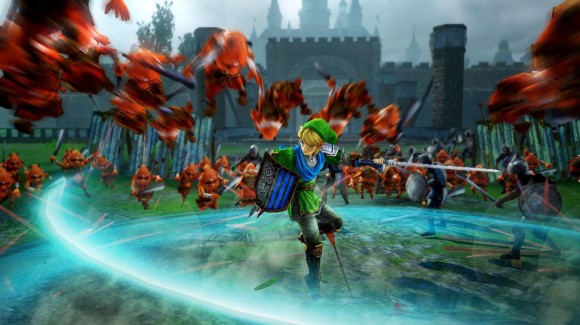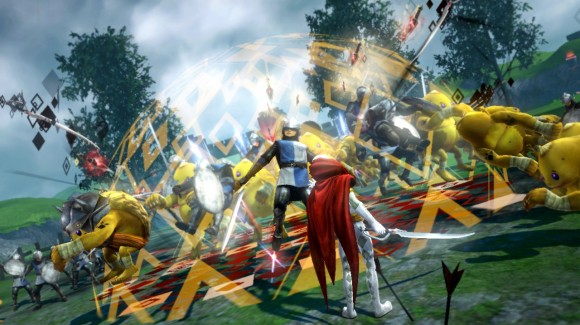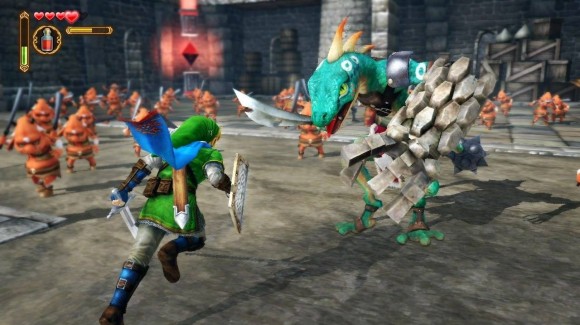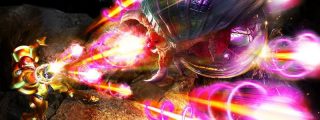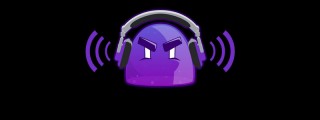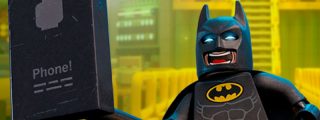Hyrule Warriors really feels like it shouldn’t exist. Sure Nintendo has loaned out their franchises to other studios before, but it’s always been franchises they clearly don’t care about like Metroid. Zelda is their baby! They can’t just let any old studio have a go at it. And yet here we are, Omega Force, the folks behind the popular Dynasty Warriors series, and Team Ninja, the folks behind the abysmal failure that was Metroid: Other M, are here to bring you the gift of Hyrule Warriors. So how is it? Well, actually a lot better than you might have been expecting.
At its core Hyrule Warriors is just a Dynasty Warriors game with a Zelda skin slapped on it. That might already be all you needed to know to send you off to the nearest store or make you vow never to pick up the game at all. If you’re not familiar with Dynasty Warriors the concept is simple, you’re a powerful hero who has been unleashed upon a very crowded battlefield. It’s your job to make sure that your side wins the battle being waged, you do this by mowing through countless insignificant enemies and paying close attention to where your opponents need to be thinned on the map.
The core of your gameplay in Hyrule Warriors will likely be working your way through the game’s story mode. Story mode runs for about 10 hours or so and will net you nine of the game’s thirteen total characters. The plot to story mode doesn’t really have much going on beyond what you would see in a standard Zelda game. A new iteration of Zelda and Link meet and find themselves attempting to thwart the villainous acts of the evil Sorceress Cia who is committing all sorts of magical atrocities in the hopes of releasing an evil whose name you almost certainly know. The mode does have some interesting branching paths, and gives you a chance to play with most of the game’s characters and weapons.
But after you finish the story mode there’s still plenty to do. The game features an “Adventure Mode” which has you navigating a map styled after The Legend Of Zelda for the NES and partaking in different battle challenges. This mode will allow you to unlock the game’s remaining four characters as well as getting you some new items and weapons.
Traditionally in a Warriors game the player character is a step below godliness and there’s no exceptions here. For the most part enemies in the game are paper thin and will only take two or three hits before dying. To a casual observer, it will look like you’re an incredible combo creating force of destruction, but only you know the dirty secret that you’re really just pressing one button the entire time. It might sound boring but mowing through gigantic waves of enemies is actually a lot of fun. The game’s challenge mostly comes less through combat and more through controlling the battlefield properly. If you lose in Hyrule Warriors it will usually be because you failed to protect your base rather than you died in a fight.
The most Zelda-esque influence to the gameplay probably comes in the form of bosses. A number of the game’s bosses are pulled from different Zelda games and each of them have their own unique weakness. The first boss you’ll come up against is King Dodongo who can take heavy damage if you toss some bombs into his mouth right as he’s sucking in. Unfortunately it seems like the game runs out of ideas by the midway point and you’ll start fighting either duplicates or ones that simply fall into a weakened status every time you avoid a combo chain.
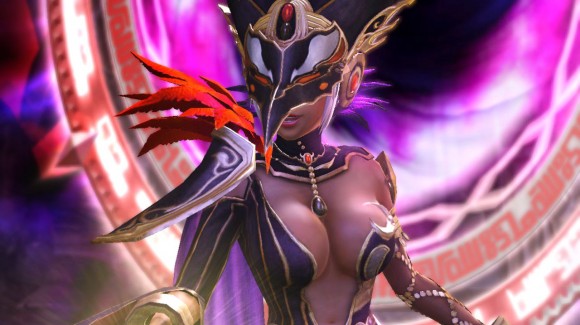
Cia’s sizable…um..assets, make me think there has to be some breast-related stipulations somewhere in the Hyrule Warriors contract.
The game allows you to upgrade your characters by crafting badges. Badges do anything from adding extra hits to your primary combo, to making you deal more damage to shielded enemies. All the crafting materials can be found on the battlefield but the game’s story mode is laid out in such a way that you can’t purchase all the upgrades you will probably want without either going back and grinding some old levels or playing a different mode for parts.
The game’s weapon crafting system had the potential to be really cool, weapons that you find will have an attack stat but will also usually have either a special bonus stat or an empty slot where a bonus can go. The crafting system allows you to combine two items, maximizing your attack damage while also porting over the bonus stats you want to keep. Unfortunately after putting in at least fifteen to twenty hours of playtime I had barely found any weapons with enough empty slots to actually utilize the system in a notable way.
If you’re so inclined you can also play Hyrule Warriors with a friend. In co-op one player uses the GamePad’s screen while the other player can hook up a Pro Controller or Nunchuck/Wiimote combo and then play off the TV. The game’s performance does dip noticeably while utilizing a second player. It’s certainly not unplayable by any means, but those who worry a lot about frames per second will want to steer clear of this mode. I was also somewhat perplexed by the game’s accessory compatibility. A Wiimote/Nunchuk worked fine, but we couldn’t ever get the game to run on the Wii Classic Controllers which would have been much more ideal.
Something else that drove me a little crazy was the game’s checkpoint system. At least two or three times throughout the game I would find myself failing an objective and losing a match only to be returned to a checkpoint that was too close to my moment of failure and made it impossible to progress. Eventually I just learned to start saving manually but it’s a shame the game’s not more conscious of whether or not its creating saves well past the point of no return.
Hyrule Warriors was kind of tricky to score. I would say if you’re just a fan of the Warriors series then it’s probably closer to a 4, if however you were hoping for a more Zelda-esque experience it’s probably closer to a 2. We’ll land right in the middle for the sake of argument, but if you’re a big fan of both series’ then there’s definitely enough here to hold your interest.


